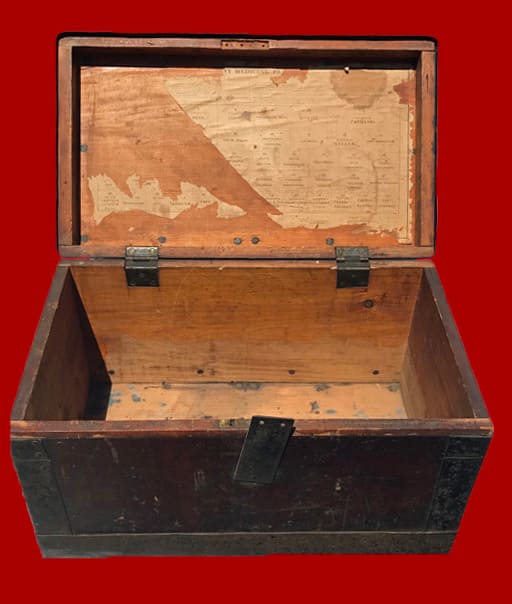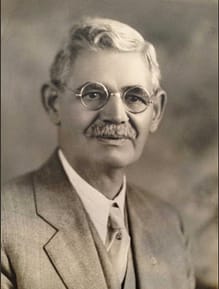ATTRIBUTED TO WILLIAM S. PURDY, MEMBER OF THE AMBULANCE CORPS

This was purchased many years ago out of West Virginia. It was sold as a “possible Wells Fargo chest”, but I knew better. When the pannier arrived, it was found to contain a leather-jacketed tool, as well as two business cards bearing the name of “Alex Purdy – Moundsville, W. Va.”, an IOOF ribbon with the name “Purdy” on it, and a clip of paper listing a “W. J. Purdy” as Assistant Superintendent for the Putnam County (W. Va.) schools. Both wooden tray inserts were missing, and it appeared to have been utilized as a tool and/or storage chest. The only features present to betray its former use as a Army Medical Pannier were the partial remnants of the list of contents still pasted to the inside of the lid of the pannier, and the structure of the chest, with the iron bound edges and corners and lock.
Some years later, I undertook some research into the chest’s former owner, Alex Purdy, in an effort to find a plausible connection to him and the medical pannier. The documentation of that journey is detailed below.
TRACING THE PURDY FAMILY BACKWARDS TO THE ORIGINAL OWNER
(USING THE CLUES FOUND)
ALEXANDER PURDY (1865 – 1830 )
The Last Owner

Alexander Purdy was born October 7, 1865 in Moundsville, Marshall county, West Virginia, to William Jonathan Purdy. From what was inside the pannier, he was probably the last owner and, judging from the content, used it as a tool chest. This was likely a common occurrence after the war. Uniform trousers were often employed as daily wear, and many other types of utilitarian objects found a second use. The two business cards with “Alex Purdy. Moundsville WV” and the IOOF ribbon belonged to Alex.
WILLIAM JONATHAN “W. J.” PURDY (1837 – 1881)
Captain Co. I, 3rd Virginia Mounted Infantry
Alex’s father, William Jonathan, known as “W. J.” is without a doubt the “W. J. Purdy” named in the clipping that was also found in the trunk. W. J. was born in 1835, and owned a “large mercantile business” in Moundsville at the start of the Civil War.
W. J. Purdy enlisted as Captain of Company I, 3rd West Virginia Infantry on July 6, 1861, but several months later submitted a letter of resignation in which he stated that although he had been elected captain “without any knowledge or consent”, he only accepted the position so that the regiment would not disband, and 3 days later marched with the regiment to muster into the service. His business suffered great financial losses during his absence, and he claimed that “pecuniary matters alone has induced me to leave the service.” His resignation was granted on February 6, 1862 by General Rosecrans.
WILLIAM S. “WILL” PURDY (1840 – 1898)
Corp. Co. I, 3rd Virginia Mounted Infantry &
Sergt. Co. I, 6th West Virginia Cavalry
Detached to the Ambulance Corps for Nine Months
Will Purdy was born in 1840, and enlisted on July 6, 1861. He was mustered into Co. I, 3rd West Virginia Infantry on July 10, with the rank of Corporal, and served under his cousin (and Alex’s father) Captain William J. Purdy:


3 Va. Infty”
(nb: Early in the Civil War, delegates from northwestern Virginia’s Unionist counties decided to break away from Virginia, which also included secessionist counties in the new state. Although West Virginia ratified its own state constitution in late 1861, West Virginia was not admitted to the Union until June 20, 1863.)
Will re-enlisted as a veteran volunteer in Feb 1864. The regiment was re-organized from a mounted infantry unit to a cavalry unit about January 1864, and re-named the 6th West Virginia Cavalry. Although Capt. W. J. Purdy did not serve for more than 6 months, his first cousin Will Purdy served nearly 5 years.
Notably, on September 25, 1863, Will was “detached” from the regiment and assigned to the Ambulance Corps, where he remained until January 1864, when his three year term expired, after which he was home on a 30 day furlough, before returning as a veteran volunteer and resuming his detachment in the Ambulance Corps until June, 1864.
The regiment was most active from August – December 1863, when it participated in Averell’s Raid. In January, things quieted down considerably and would remain so for the remainder of the war. It is quite possible that at some point, maybe during his furlough from January to February, he brought the pannier/chest home with him. There may or not have been any contents left in it by that time; perhaps it was reduced to a sturdy chest that would otherwise be destined as firewood. To me, this is the most logical explanation of ow the chest ended up in Alex Purdy’s hands…
“AVERELL’S RAID”
THE 3rd VIRGINIA MOUNTED INFANTRY AND 6th WEST VIRGINIA CAVALRY
(FROM SEPT. 1863 – JUNE 1864)
From June 1861 through December 1863, the regiment was known as the 3rd Virginia Infantry (it became mounted in May 1863). Starting in August 1863, the unit was in a separate brigade under the command of Brig.-Gen. William Woods Averell. Averell’s West Virginia command consisted primarily of cavalry and mounted infantry from West Virginia and Pennsylvania.
Averell’s Raid of August 1863 was the first of three Union cavalry raids launched from West Virginia toward Confederate railroads and troop and supply concentrations in western Virginia during the latter half of 1863. The second raid in November culminated in a Union victory in the Battle of Droop Mountain, while the third, known as the Salem Raid, took place in December and resulted in partial destruction of the Virginia & Tennessee Railroad, a key Confederate communications link. Averell regarded the Salem Raid as the greatest success.
Will Purdy was in the Brigade’s Ambulance Corps for essentially the entire time Averell was conducting his raids. The casualties in the battle of Droop Mountain alone (November 6, 1863) were 45 men killed, including those mortally wounded. There were 93 wounded and 2 captured.
On January 26, 1864, the regiment was re-designated as the 6th West Virginia Cavalry. It was then attached to the 3rd Brigade, 4th Division, Army West Virginia (to April, 1864), and the 3rd Brigade, 2nd Cavalry Division, West Virginia, (to June, 1864). During this time, things would have been quiet, since the regiment was on duty at Martinsburg, WV until March, 1864. From that time until June, there were only sporadic detachments sent to various areas in West Virginia.
THE U.S. AMBULANCE CORPS IN THE CIVIL WAR
Early in the Civil War, no organized system of battlefield evacuation existed. Regimental bands men were ordered to transport the wounded creating a muddled system where wounded men could suffer on the battlefield for over a week. There was no overall plan for evacuation and hospitalization of casualties. There was no unity, a lack of equipment, and facilities or integrated system of support. Ambulance drivers were generally either pressured soldiers or wagon and hack drivers pulled from the streets of Washington, D.C. Surgeons reported drivers who were insubordinate, drunk or who appropriated space inside the ambulances intended for blankets and food. As to the vehicles themselves, the Army had been forced to round up commercial wagons and hacks to serve as ambulances.
Jonathan Letterman, medical director of the Army of the Potomac, established an integrated medical capability based on three principal elements: a coordinated system of casualty evacuation from the point of wounding back through the division rear; organization of medical logistics, including supply tables and transportation; and establishment of division field hospitals as part of the evacuation chain.
On August 2, 1862, under Letterman’s instruction, Gen. George B. McClellan created the United States Army’s first full-time, dedicated Ambulance Corps. His general order determined the structure, training and role of the service; and were a blueprint for the creation of subsequent Ambulance Corps later in the war. His plan placed all ambulances under the control of the medical director. Captains commanded the corps-level ambulance organization, first lieutenants commanded at the division level, second lieutenants led at the brigade level, and sergeants at the regimental level.


Letterman’s use of non-physician officers to command ambulance units represented a significant shift in Army Medical Department policy. His intent was to relieve the physicians from duties that distracted them from their primary mission of patient care. Two-patient ambulances, each with two privates and a driver, were allocated on the basis of three for each infantry regiment, two for each cavalry regiment, and one for each artillery battery. Two supply wagons were assigned to each division’s ambulance corps. Only medical personnel were permitted to accompany the sick and wounded to the rear, and only patients were allowed to ride in the ambulances. This instigated a major improvement in battlefield medicine.
One marked “FORAGE”, another “HOSPITAL DEPARTMENT”
(The “X” is for the Sixth Corps of the Army of the Potomac, not a medical symbol)
The pannier was part of the transport wagons used by the Ambulance Corps on their duties in the field – as is depicted in the sketch below ( taken from “Diagram Illustrating the Principle Means Used in Transporting the Sick and Wounded and Medical Supplies during the War of the Rebellion”)


In March, 1864, a permanent ambulance corps was created. The law authorized corps commanders to detail officers and enlisted soldiers to form their ambulance organizations and provided for the examination of candidates by boards of medical officers. As one citizens’ committee put it, the Army should carefully screen the officer candidates because of the special trust it placed in them, and they should “at least equal the best of the fighting-men in gallantry.” It also gave commanders the authority to create a distinctive uniform for members of the Ambulance Corps.
By the end of the war, the Medical Department declined in numbers, and the laws created to prosecute the war expired when the war ended. By 1866, the Ambulance Corps no longer existed.








